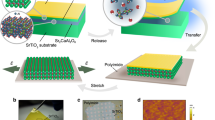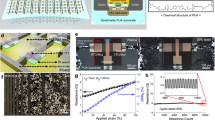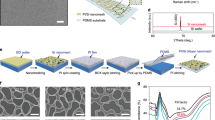Abstract
Strain plays a critical role in the properties of materials. In silicon and silicon–germanium, strain provides a mechanism for control of both carrier mobility and band offsets. In materials integration, strain is typically tuned through the use of dislocations and elemental composition. We demonstrate a versatile method to control strain by fabricating membranes in which the final strain state is controlled by elastic strain sharing, that is, without the formation of defects. We grow Si/SiGe layers on a substrate from which they can be released, forming nanomembranes. X-ray-diffraction measurements confirm a final strain predicted by elasticity theory. The effectiveness of elastic strain to alter electronic properties is demonstrated by low-temperature longitudinal Hall-effect measurements on a strained-silicon quantum well before and after release. Elastic strain sharing and film transfer offer an intriguing path towards complex, multiple-layer structures in which each layer’s properties are controlled elastically, without the introduction of undesirable defects.
This is a preview of subscription content, access via your institution
Access options
Subscribe to this journal
Receive 12 print issues and online access
$259.00 per year
only $21.58 per issue
Buy this article
- Purchase on Springer Link
- Instant access to full article PDF
Prices may be subject to local taxes which are calculated during checkout




Similar content being viewed by others
References
Ieong, M., Doris, B., Kedzierski, J., Rim, K. & Yang, M. Silicon device scaling to the sub-10-nm regime. Science 306, 2057–2060 (2004).
Rim, K., Hoyt, J. L. & Gibbons, J. F. Fabrication and analysis of deep submicron strained-Si N-MOSFET’s. IEEE Trans. Electron Devices 47, 1406–1415 (2000).
Mooney, P. M. & Chu, J. O. Heteroepitaxy and high-speed microelectronics. Annu. Rev. Mater. Sci. 30, 335–362 (2000).
Fitzgerald, E. A. et al. Relaxed GexSi1−x structures for III-V integration with Si and high mobility two-dimensional electron gases in Si. J. Vac. Sci. Technol. B 10, 1807–1819 (1992).
Ismail, K. et al. Identification of a mobility-limiting scattering mechanism iin modulation-doped Si/SiGe heterostructures. Phys. Rev. Lett. 73, 3447–3450 (1994).
Monroe, D., Xie, Y. H., Fitzgerald, E. A., Silverman, P. J. & Watson, G. P. Comparison of mobility-limiting mechanisms in high-mobility Si1−xGex heterostructures. J. Vac. Sci. Technol. B 11, 1731–1737 (1993).
Lo, Y. H. New approach to grow pseudomorphic structures over the critical thickness. Appl. Phys. Lett. 59, 2311–2313 (1991).
Brown, A. S. Compliant substrate technology: Status and prospects. J. Vac. Sci. Technol. B 16, 2308–2312 (1998).
Hobart, K. D. et al. Compliant substrates: A comparative study of the relaxation mechanisms of strained films bonded to high and low viscosity oxides. J. Electron. Mater. 29, 897–900 (2000).
Yin, H. et al. Buckling suppression of SiGe islands on compliant substrates. J. Appl. Phys. 94, 6875–6882 (2003).
Ejeckam, F. E., Lo, Y. H., Subramanian, S., Hou, H. Q. & Hammons, B. E. Lattice engineered compliant substrate for defect-free heteroepitaxial growth. Appl. Phys. Lett. 70, 1685–1687 (1997).
Mooney, P. M., Cohen, G. M., Chu, J. O. & Murray, C. E. Elastic strain relaxation in free-standing SiGe/Si structures. Appl. Phys. Lett. 84, 1093–1095 (2004).
Jones, A. M. et al. Long-wavelength InGaAs quantum wells grown without strain-induced warping on InGaAs compliant membranes above a GaAs substrate. Appl. Phys. Lett. 74, 1000–1002 (1999).
Cohen, G. M., Mooney, P. M., Paruchuri, V. K. & Hovel, H. J. Dislocation-free strained silicon-on-silicon by in-place bonding. Appl. Phys. Lett. 86, 251902 (2005).
Damlencourt, J.-F. et al. Paramorphic growth: A new approach in mismatched heteroepitaxy to prepare fuly relaxed materials. Jpn J. Appl. Phys. 38, L996–L999 (1999).
Boudaa, M. et al. Growth and characterization of totally relaxed InGaAs thick layers on strain-relaxed paramorphic InP substrates. J. Electron. Mater. 33, 833–839 (2004).
Demeester, P., Pollentier, I., De Dobbelaere, P., Brys, C. & Van Daele, P. Epitaxial lift-off and its applications. Semicond. Sci. Technol. 8, 1124–1135 (1993).
Menard, E., Lee, K. J., Khang, D.-Y., Nuzzo, R. G. & Rogers, J. A. A printable form of silicon for high performance thin film transistors plastic substrates. Appl. Phys. Lett. 84, 5398–5400 (2004).
Yablonovitch, E., Hwang, D. M., Gmitter, T. J., Forez, L. T. & Harbison, J. P. Van der Waals bonding of GaAs epitaxial liftoff films onto arbitrary substrates. Appl. Phys. Lett. 56, 2419–2421 (1990).
Langdo, T. A. et al. SiGe-free strained Si on insulator by wafer bonding and layer transfer. Appl. Phys. Lett. 82, 4256–4258 (2003).
Moriceau, H. et al. New layer transfers obtained by the SmartCut process. J. Electron. Mater. 32, 829–835 (2003).
Freund, L. B. & Suresh, S. Thin Film Materials (Cambridge Univ. Press, Cambridge, 2003).
van Houten, H., Williamson, J. G., Broekaart, M. E. I., Foxon, C. T. & Harris, J. J. Magnetoresistance in a GaAs/AlxGa1−xAs heterostructure with double subband occupancy. Phys. Rev. B 37, 2756–2758 (1988).
Beenakker, C. W. J. & van Houten, H. Quantum transport in semiconductor nanosturctures. Solid State Phys. 44, 1 (1991).
Schäffler, F. High-mobility Si and Ge structures. Semicond. Sci. Technol. 12, 1515–1549 (1997).
Acknowledgements
This research was supported by DOE, NSF-MRSEC, AFOSR, NSF-ITR, ARDA, ARO and NSA.
Author information
Authors and Affiliations
Corresponding author
Ethics declarations
Competing interests
Three of the authors, M. M. Roberts, D. E. Savage and M. G. Lagally, are listed as inventors on U.S. Patent application #P04286US, "Fabrication of Silicon-Germanium Heterojunction Structures", filed December 16, 2004. G. Celler is employed by Soitec, a maker of silicon-on-insulator.
Rights and permissions
About this article
Cite this article
Roberts, M., Klein, L., Savage, D. et al. Elastically relaxed free-standing strained-silicon nanomembranes. Nature Mater 5, 388–393 (2006). https://doi.org/10.1038/nmat1606
Received:
Accepted:
Published:
Issue Date:
DOI: https://doi.org/10.1038/nmat1606
This article is cited by
-
Quality Improvement of GaN Epi-layers Grown with a Strain-Releasing Scheme on Suspended Ultrathin Si Nanofilm Substrate
Nanoscale Research Letters (2022)
-
Defect free strain relaxation of microcrystals on mesoporous patterned silicon
Nature Communications (2022)
-
Light-responsive self-strained organic semiconductor for large flexible OFET sensing array
Nature Communications (2022)
-
Heterogeneous integration of single-crystalline rutile nanomembranes with steep phase transition on silicon substrates
Nature Communications (2021)
-
Epitaxy, exfoliation, and strain-induced magnetism in rippled Heusler membranes
Nature Communications (2021)



